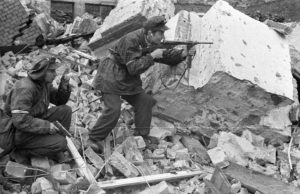1944
The Warsaw Uprising Begins
When Nazi armies collaborated with the Soviet Red Army in overrunning Poland in the autumn of 1939, the occupying forces set out to eradicate Polish identity. Both the Germans and Russians took special care to imprison and murder the country’s intellectual, artistic, political and military leaders. The Nazis aimed to rid the country of its Slavic population and replace it with German colonists; the USSR aimed to Sovietize the Poles; both wished to erase Poland from the map.
Patriotic Poles, however, continued to resist; some inside the country in partisan units devoted to sabotage; some outside the country in the armies of the Allies. Polish fliers participated in the Battle of Britain; Polish soldiers battled the Germans in Italy and on D-Day in France. Unfortunately there was no political union, no single government-in-exile that could speak for Poland — a pro-western group was based in London and a pro-Soviet group operated from Moscow. When Poles exposed the Soviet perpetrators of the 1940 Katyn massacre of Polish officers, the USSR curtailed cooperation with the western group. This was to prove fatal in 1944.
For years the Polish Home Army and other partisan groups had been harassing German forces and arming for a general uprising. Some of these units had assisted Polish Jews in their doomed battle for the Warsaw Ghetto and all looked forward to the advance of Allied armies. By the summer of 1944 it was apparent that the Red Army would be the first to liberate Poland and it was decided that a mass rebellion would begin on August 1. The plan was to take control of Warsaw and then link up with advancing Russian forces to drive the Germans out of the rest of the country.
On August 1 tens of thousands of Poles attacked German bunkers and fortifications in Warsaw. For four days they scored successes, occupying much of the centre of the capital, liberating a concentration camp and causing Germans to withdraw. However, the Red Army halted its advance and refused to come to the aid of the Poles; Stalin refused British and American airforces permission to drop supplies. When the western Allies flew over Poland anyway, Stalin refused permission for them to land in territory under Red control, thus limiting the capacity and effectiveness of the airdrops. The Germans, on the other hand, were able to rush reinforcements into the city. After a while stalemate, turned to siege, civilians and partisans began to starve and German troops carried out massacres of inhabitants in order to break the will of the resistance. Fighting continued until early October by which time much of the city was in flames, Home Army troops had surrendered and the civilians were forced out of Warsaw, 85% of which had been destroyed in the fighting or in the aftermath by vengeful German troops.
